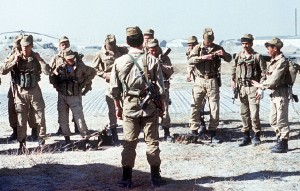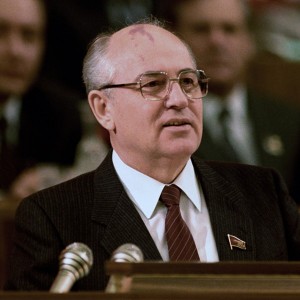My teens spanned the 1970s, memorable for being a decade of economic recession, the emergence of neoliberal politics and economics, and the accelerating polarization of the world between the United States (and its NATO allies) and the Soviet Union. The decade ended with the election of British Prime Minister Margaret Thatcher and the Soviet invasion of Afghanistan.
During the early 1980s I became more politically aware. It seemed then that European politics was dominated by the apparently impregnable wall separating East from West and of the vast Soviet empire whose ranks were massed behind it. Our home in the UK received, as did many other homes of the era, a booklet outlining what to do in the event of a nuclear attack. The perception and presentation of this kind of cold war ‘reality’ was further fuelled for a young evangelical by the atheism and godlessness to which the Soviet socialist states pledged their unwavering allegiance.
Iron curtain drawn back
Mikhail Gorbachev became leader of the Soviet Union in 1985 and a succession of Western leaders engaged his attempts to decrease tensions with the West, accompanied by the introduction of domestic political and economic liberalisation. As communist governments crumbled during 1989, the reunification of Germany in 1990 became inevitable, along with the demise of cold-war political and geographical realities. The ‘iron curtain’ that had separated ‘Eastern’ Europe from the ‘West’ was finally drawn back.
I have now lived half of my lifetime in the wake of the political, economic, social, and religious changes that were ushered in by the events of the late 1980s and early 1990s. A mere 15 years after the political changes, I moved with my wife to take up a mission position based in Hungary, a relocation that would have been inconceivable in 1989. We were there to take advantage of the central location of Budapest in the geography of the new Europe.
Other mission agencies with a similar pan-European focus to ours found that Budapest was a useful base from which to gain rapid access to most of Europe. Budapest, as a capital city that had been formerly described as ‘Eastern Europe’ (implying that it was on the edge of modern and progressive Europe) had now become a central European capital with easy access to all parts of it.
This article attempts to capture, albeit impressionistically, something of the most significant developments of the last quarter of a century in Europe. Having done that I will then try to outline and review some of the main implications that these changes continue to pose to evangelical mission agencies and their related church communities.
Nationhood, independence, and ethnicity
For much of the post-war period through until the late 1980s, Europe’s internal conflicts were generally framed in a way that opposed the ‘East’ with the ‘West’. Of course, this obscured tensions and conflict internal to each of these two European regions, tensions that would later emerge with lethal consequences in the countries of the Balkans.
When the overly simplistic East-West account of European identity collapsed, a vacuum emerged in which it was possible for powerful and lethal tribalism to emerge around the notions of newly emerging nations.[1] In most instances these contemporary forms of tribalism were built around identities that were taken to be ethnically homogenous and frequently shaped with reference to historical religious identities (Orthodox, Catholic, and Muslim) that had been suppressed by communist regimes.
In its most extreme and violent expression, armed conflict ravaged former Yugoslavia for the eight years between 1991 and 1999, resulting in approximately 140,000 deaths and massive damage to the infrastructure and economy of the region. Competing nationalist aspirations and ethnic tensions fed these wars. Although armed hostilities in the Balkans finally ceased with the ending of the Kosovo War in 1999, regional tensions remain and continue to hamper the access and activities of mission agencies working in these regions.
Of course the aspiration to nationhood and self-determination is not always malignant and, in the case of Slovakia and the Czech Republic, saw a separation of the former Czechoslovakia during the ‘Velvet Revolution’ into its constituent territories. As the countries of Hungary, the Czech Republic, Slovakia, and Slovenia, for example, addressed their self-identification, they quickly embraced the language of ‘Central Europe’. This served two purposes. Firstly, it allowed these and other countries to jettison the old socialist-era language of ‘the East’. Secondly, it enabled them to forge a common sense of regional identity and shared purpose.
As the European Union extended its borders with the accession of new member states in 2004, 2007, and 2013, citizens of all 28 EU countries gained the freedom to live and work across the entire EU community. In each EU country, with this new freedom to migrate, populations are beginning to experience new forms of internal ethnic and national diversity. In some instances, this factor has fuelled ethnic and nationalist tensions. These, in turn, drive Euro-sceptical movements and political parties, lend support to forms of political extremism targeted at ethnic minorities, and entrench resistance to particular groups of immigrants.
National governments of the former ‘West’ are also sensitive to internal tensions that may be regional and historic. In the case of Scotland, the political machinery gathered sufficient momentum towards a referendum on independence from the United Kingdom in 2014 which ultimately proved unsuccessful. Moreover, similar aspirations continue to stir the desire for independence in Catalonia and other regions of Spain—moves consistently resisted by the Spanish central government.
New forms of political alliance
Of course, the European Union, with 28 member states, is not the only institution that represents the joint interests of European nations. The older Council of Europe (established in 1949) represents 47 member states, including the former Soviet states that remain outside EU membership (with the notable exception of Belarus, the only outstanding dictatorship in Europe). However, as an effective instrument of joint policy-making, the EU is by far the more effective of the two bodies.
With the expansion of the EU in 2004, 2007, and 2013, the EU has grown from a membership of 15 to 28 countries. Eleven of these new EU member states were located within the Soviet bloc prior to 1989. The six-month presidency of the European Union has been held by each of the countries of the former Soviet bloc which are now members of the EU.
A further four countries are either formal candidates for the EU or have potential candidate status (Albania, Macedonia, Bosnia-Herzegovina, and Kosovo) and two (Montenegro and Serbia) are negotiating a roadmap towards accession.
The demise of the former Soviet Union paved the way for the emergence of the Commonwealth of Independent States (CIS). The CIS promotes the common interests of its members and, to an extent, one of its outcomes ensures the maintenance of closer ties among ethnic Russians or Russian-speaking passport holders in what Russia frequently refers to as its ‘near abroad’:
- The presence of ethnic Russians in Ukraine and Georgia lent justification to Moscow’s claims of protecting Russians living in Ukrainian territory in Crimea and its control of former Georgian territory in South Ossetia and Abkhazia.
- Moldova is also vulnerable in this regard, having its own ethnic Russian population in the Transnistria region, east of the Dniester River and bordering Ukraine.
- While the three Baltic States also have ethnic Russian populations, they are afforded the relative protection of NATO membership. However, instances of air-space intrusions by Russian forces intensified throughout 2015 in developments that some interpret as Soviet-style provocations along borders that were formerly located wholly or partially within the Soviet Union.
Increasing cultural and religious diversity
For citizens of a majority of EU states, the Schengen Agreement has guaranteed the freedom of unrestricted passage across national borders that are internal to the Schengen Zone. EU citizens have the right to reside, work, and conduct business in any one of the EU’s member states. This has contributed to healthy patterns of cultural and religious diversity.
As the scale of non-EU migration into Europe accelerated across 2014-2015, several member states enacted unilateral measures intended to control the entry of migrants into their territory, including the erection of border fences. This has contributed to the pressure for Brussels-based European politicians to enact Article 26 of the Schengen Agreement which allowed for the temporary re-introduction of border checks if there were ‘persistent serious deficiencies’ at the external border. In late 2015 it was decided to allow the re-introduction of temporary border checks for a period of up to two years. This will also mean stricter external border controls.
The presence of immigrants in Europe has accelerated its cultural and religious diversity and prompted new policy and political responses. During the mid-years of the ‘noughties’ European politicians began to announce the demise of multiculturalism. Accompanying this was a new focus on ‘interculturalism’ that promoted a more intentional approach to the integration of migrants through policies supporting language acquisition, entry into education and the workforce, and the promotion of national or European values (assessed formally in some countries).[2]
With cultural diversity came religious diversity and an increasing European sensitivity towards Islam, particularly in the form of the more radical Muslim groups. The secular 1970s did not prepare Europe well for the religious vitality that would become all too apparent during the late 1990s and onwards.
Religious conviction was implicit in the various Balkans conflicts with, for example, Serbian Orthodox fighting against Bosnian Muslims and Croatian Catholics. The use of religious labels is unconvincing to most theologians or religious teachers. However, their adoption by various movements has been remarkable in creating and sustaining committed identity and purpose, especially where these are directed towards the pursuit of violence.
Church and mission in Europe
Over the last 25 years, there seems to have been a sober re-assessment of the evangelical euphoria that was apparent during the early 1990s in Central and Eastern Europe. Cynics at the time suggested that the call to conversion in the 1990s seemed to be ‘Repent, believe, be baptised, and take a truckload of Bibles and children’s clothes to an orphanage in Romania!’
Despite such objections, these early years saw an unprecedented openness to the Gospel, new religious freedoms, and a plethora of church planting ministries, Bible and literature distribution, social ministries, and evangelistic initiatives. This was bolstered by the arrival of large numbers of missionaries from the USA, Korea, and various western European mission agencies. Effective partnerships led to the establishing of many more local evangelical congregations in parts of Europe.
However, the presence of missionaries was not without its tensions. Their presence was resented almost unanimously by the traditional churches (Orthodox and Catholic) and not infrequently by existing evangelical churches which experienced the loss of formerly active members to non-indigenous churches that were well funded and resourced from the West.
The missionary activity of recent years has become more sensitive to the local context. Church planting from the West has lost the appeal of its novelty. Sustained and longer-term approaches are seen to be more appropriate. There are also, for example, innovative examples of evangelical co-operation with traditional churches, notably from among mission societies such as the British CMS or the German EMW and agencies such as World Vision.
In taking seriously their missionary commitment to Europe, there are also Christian churches and individuals who understand the need to engage their Christian worldview with the largely secular corridors of political, economic, cultural, social, and educational power.[3] The European Union and its Commission are now required to serve and reflect the interests of 28 countries. Many of these are much more ‘non-secular’ than the pre-2004 ‘club of 15’. Engaging with European institutions will remain problematic for evangelicals and other people of faith but it does at least open up the possibility of another way of re-introducing the people of Europe to a convincing and compelling account of the Christian faith and the witness it gives to the Gospel of Jesus.
(Adapted and extended from an article originally published in Vista: Quarterly bulletin of research-based information on mission in Europe, No 19, October 2014.)
Endnotes
- Editor’s Note: See article entitled ‘Nationalism and Evangelical Mission: Issues for evangelical leaders’ by Darrell Jackson in the May 2014 issue of Lausanne Global Analysis.
- Editor’s Note: See article entitled ‘European Immigration Policy: Lessons and challenges for the church’ by Darrell Jackson in the January 2013 issue of Lausanne Global Analysis.
- Editor’s Note: See article entitled ‘Europe: A most strategic mission field’ by Jeff Fountain in the November 2014 issue of Lausanne Global Analysis.



